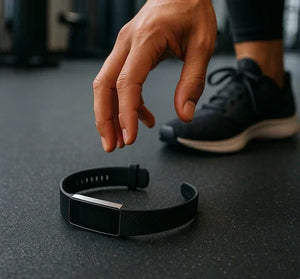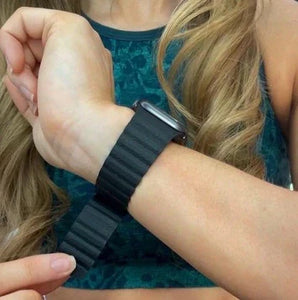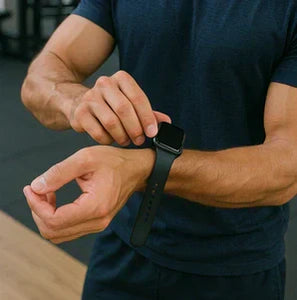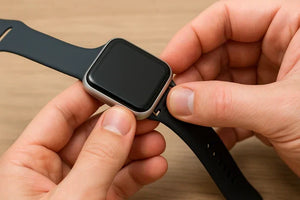Why the Apple Move Goal Matters More Than You Think
“Movement is a medicine for creating change in a person’s physical, emotional, and mental states” – Carol Welch
In a 2022 systematic review that was published in The Lancet Digital Health, researchers found that wearable activity trackers, such as the Apple Watch, actively encourage users to walk an average of 1,800 extra steps per day, which in turn leads to significant health benefits, including weight loss and improved cardiovascular health.

The Move goal on your Apple Watch is designed to promote consistent daily activity by setting a personalised target for active calories burned. As the most dynamic of the three Activity Rings (Move, Exercise, Stand), it plays a crucial role in measuring your active energy expenditure, encompassing all movements from taxing gym sessions to everyday activities like walking to the shops.
For fitness lovers and casual Apple Watch users alike, achieving your Move goal keeps you motivated and reinforces healthy habits. No one could argue that sedentary lifestyles are more common than ever. Your Apple Move goal serves as a personal metric to keep you engaged and accountable for your fitness levels. Pairing your Apple Watch with a comfortable, breathable watch strap, such as Fitstraps’ Sports Style Apple Watch Straps, ensures that nothing holds you back from closing your rings each day.
🚀 Want to make hitting your Move goal even easier? Upgrade your strap to something that moves with you —
Find a performance band that fits your pace from the Fitstraps range.

What Should my Move Goal be Apple Watch?
This is a really common question that pops up more than you’d think: “What should my move goal be on the Apple Watch?” And the answer? It really depends, but there are some smart starting points.
Apple’s default Move goal is set to 300 active kilocalories per day, which suits the average adult’s lifestyle. But let’s be honest, “average” isn’t a great metric if you’re training hard and chasing the goal of improved long-term health.
Here’s a rough guide to help you fine-tune your target:
-
🧘 Beginners or those with more sedentary lifestyles – 250–350 kcal
-
🚶 Lightly active users – 400–600 kcal
-
🏋️ Highly active or athletic users – 600–1,000+ kcal
Your Move goal should reflect your baseline activity level plus a challenge that’s realistic. As Apple itself puts it nicely:
“Your Move goal is personal. It should be something you can reach with effort, but still push you to keep improving.” – Apple Support
The key here is being sustainable and consistent with your goal. There’s no prize for setting a sky-high Move goal and failing to meet it. The magic is in building consistency and letting the Move ring close each day without it becoming a stressor on your lifestyle.
And don’t forget: your Apple Watch gives you a weekly prompt to update your goal based on your performance. That’s your cue to level up when you're ready, or to dial it back if you're in recovery mode.
Whether you're chasing PBs on the rowing machine at the gym or just want to stay accountable during your relaxing lunchtime walks, your Apple Move goal should always match your lifestyle, not someone else’s.
🧘 Want something that works and looks good while you hit your Move goal?
Check out our favourite strap styles for active women — designed to keep up with you, from the gym to brunch and everywhere in between. ✨

How the Apple Move Goal Relates to Calories In vs Calories Out
At its core, the Apple Watch Move goal is a clever tool for managing your energy balance, the relationship between the calories you burn and the calories you consume on a daily basis. Get that balance wrong, and your results will stall. Get it right, and the Move ring becomes a powerful tool in your fitness journey.
So, let’s look in some more detail.
Your total daily energy expenditure (TDEE) is made up of several components:
-
🧠 Basal Metabolic Rate (BMR): The calories your body burns when resting.
-
🚶 Non-Exercise Activity Thermogenesis (NEAT): Walking and daily movement
-
🏋️ Exercise: Your workouts and structured training sessions
-
🍕 Thermic Effect of Food: Calories used to digest and absorb nutrients
The Apple Move goal focuses primarily on active calories, which refers to the energy you burn through movement, whether that’s gym time, a dog walk in the evening or a mad dash to get your kids ready for school in the morning. It doesn’t include your BMR. That’s why your total calories burned (which you can also see in the Fitness app) is always higher than what your Move ring shows.
So, how does this actually relate to your goals?
-
🔻Is your goal fat loss? Your Move goal can help create a daily calorie deficit. Let’s say your maintenance calories per day are 2,500, and you're eating 2,200 kcal per day. If your Move goal is set to 500–600 kcal, you’re already tipping the scales toward weight loss in a nice sustainable way, as long as your nutrition stays on track.
-
🟰 Maintenance? You’ll want your Move goal to reflect your intake so you maintain a neutral energy balance.
-
🔺 Bulking or Performance? You might raise your Move goal to stay active without overreaching, especially if you’re increasing food intake.
So next time you close that red ring, know this: you’re not just burning calories, you’re mastering your energy equation.
How Your Apple Move Goal Is Calculated (and Why It’s Not One-Size-Fits-All)
Ever wonder why your friend’s Apple Watch has a totally different Move goal than yours? It’s not random; Apple’s algorithm is quietly working in the background to estimate your daily active calorie burn, and it’s a surprisingly sophisticated piece of tech.
When you first set up your Apple Watch, it asks you to input some key data: age, sex, height, weight, and activity level. These variables are used to estimate your Basal Metabolic Rate (BMR, which we spoke about above) and overall energy expenditure. From there, Apple recommends the starting Move goal, which is usually 300 kcal, which you can manually adjust.
But here’s where it gets interesting.
Your Apple Watch uses its accelerometer, heart rate sensor, GPS (if enabled), and motion data to monitor how you move throughout the day. It then assigns a calorie value to each movement based on intensity and duration.
For example:
-
A brisk walk down to the shops might burn 80–100 kcal/hour
-
A taxing gym session could burn 400–600 kcal/hour
-
A low-intensity yoga flow might stay closer to 150 kcal/hour
It also takes into account your heart rate variability, which means that someone with a higher resting heart rate may register more calories burned during the same activity as someone with a lower one.
Apple encourages all users to review and adjust their goals weekly based on performance. In fact, you'll get a "Time to update your Move goal?" prompt every seven days. This adaptive approach keeps you challenged, but makes sure you are not overwhelmed with it.
And if you’re training for something specific (like a HYROX event, a half-marathon, or just building better health habits), metrics like heart rate zones and VO2 max readings on Apple Watch can help fine-tune your intensity.

The Best Apple Watch Straps to Keep You Moving
So, you’re closing those rings, smashing goals, and getting fitter day by day, but there’s one thing many Apple Watch users overlook: the watch strap. When your wristwear isn’t comfortable, breathable, or suited to your lifestyle, it can quietly sabotage your progress and make it less enjoyable. And for anyone who’s ever dealt with strap rash or discomfort, you’ll know how quickly that can derail your motivation to move.
At FitstrapsUK, we’ve seen it all: frayed nylon bands, itchy rubber, and “premium” straps that fall apart after a month. That’s why we created watch straps built specifically for movement, comfort, and durability, all without compromising on style.
So, let’s match your Move goal Apple Watch activity to the strap that’ll go the distance with you:
🏋️ For Gym Sessions & HIIT Workouts
Fitstraps Sports Style Apple Watch Straps
Designed with perforated holes for airflow and ultra-durable silicone, these are made to handle sweat, speed, and high-intensity training. A must-have for anyone chasing that 600+ kcal Move ring goal!
🧘 For Everyday Wear & Light Activity
Classic Silicone Apple Watch Straps
Soft on the skin and built for all-day comfort. Whether you’re out walking or running errands, these are the ultimate blend of low-profile comfort and movement flexibility.
🎯 For Performance and Style
Nylon Apple Watch Straps
Lightweight and secure, these straps are perfect for functional training, running, or even outdoor hikes. Quick-drying and breathable, they’ll move with you no matter how you train.
🍸 For Smart-Casual Fitness Vibes
Metal Apple Watch Straps
Who says hitting your Move goal can’t look good? Ideal for professionals who wear their Apple Watch from the office to evening, all while closing rings with confidence.
🏃 If your Apple Watch is tracking your movement every day, don’t let a poor-quality strap slow you down. Upgrade to a Fitstrap that works as hard as you do.
👉 Find a band that moves with you — shop the Fitstraps performance collection
 Finding the Best Fitbit Band for Sleeping
Finding the Best Fitbit Band for Sleeping
 Finding a Christmas Apple Watch Strap: Celebrate the Season in Style
Finding a Christmas Apple Watch Strap: Celebrate the Season in Style
 Why Does My Fitbit Strap Keep Falling Off?
Why Does My Fitbit Strap Keep Falling Off?
 Adjusting Your Apple Watch Band For A Better Fit
Adjusting Your Apple Watch Band For A Better Fit
 Are Apple Watch Straps Dangerous?
Are Apple Watch Straps Dangerous?
 How To Fix an Apple Watch Strap
How To Fix an Apple Watch Strap
 Cool Fitbit Versa 2 Bands: Style, Comfort, and Performance Combined
Cool Fitbit Versa 2 Bands: Style, Comfort, and Performance Combined
 Mens Leather Apple Watch Strap Styles Built for Everyday Sophistication
Mens Leather Apple Watch Strap Styles Built for Everyday Sophistication




